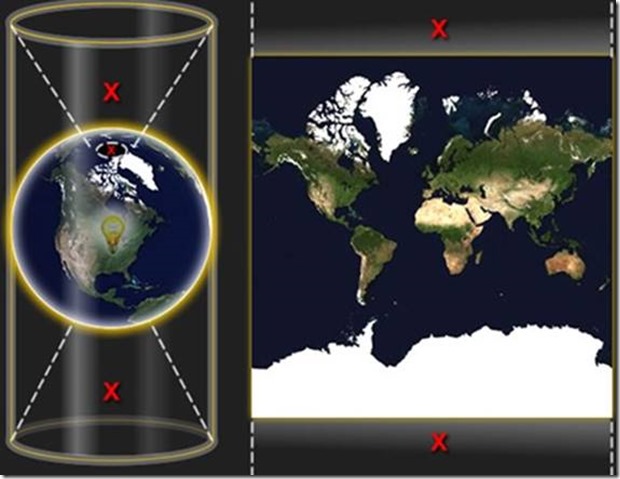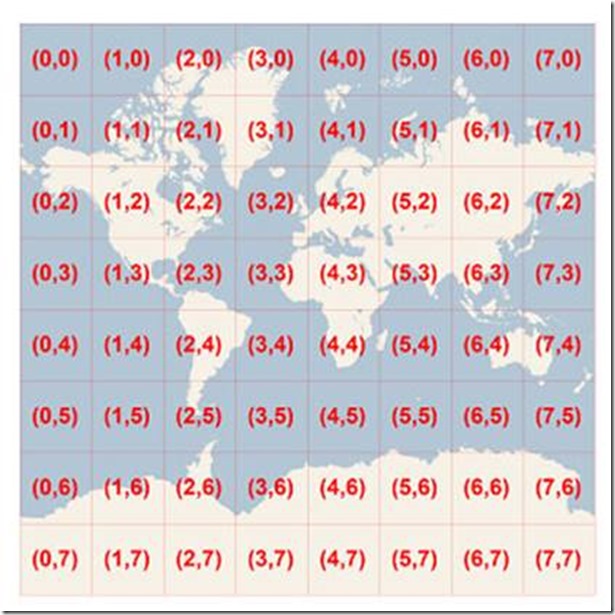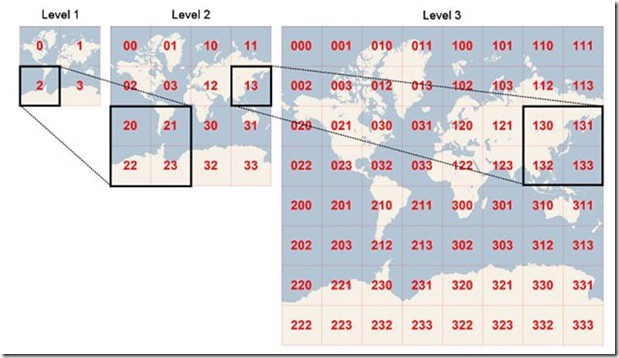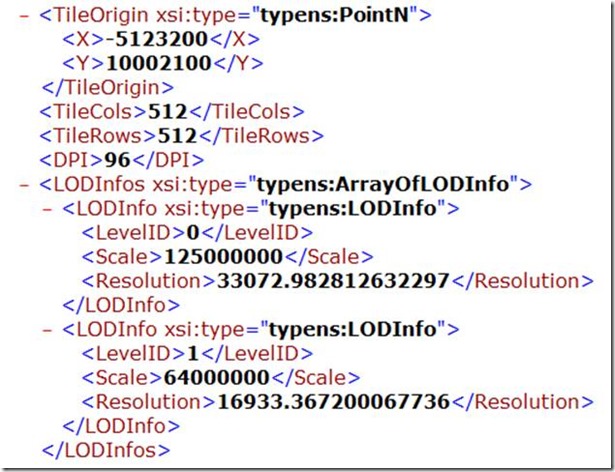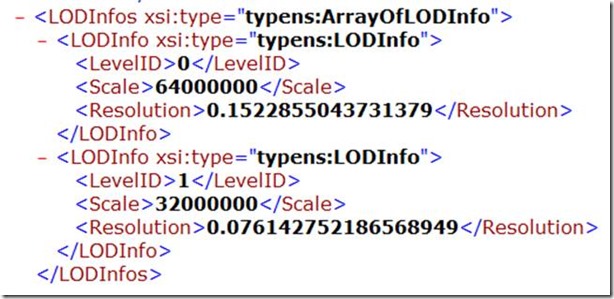中国地图大地理2000坐标系对应啥投影坐标系
Posted
tags:
篇首语:本文由小常识网(cha138.com)小编为大家整理,主要介绍了中国地图大地理2000坐标系对应啥投影坐标系相关的知识,希望对你有一定的参考价值。
参考技术A 中国地图大地理2000坐标系是地理坐标系,缩写为CGCS2000坐标系,下面是坐标系的一些参数,长短半轴、参考椭球等信息:CGCS2000对应的投影坐标系,采用高斯克吕格投影,可采用以下投影,同时选用哪个投影带需要根据你数据的位置进行确定。
墨卡托投影地理坐标系地面分辨率地图比例尺
GIS理论(墨卡托投影、地理坐标系、地面分辨率、地图比例尺、Bing Maps Tile System)
墨卡托投影(Mercator Projection),又名“等角正轴圆柱投影”,荷兰地图学家墨卡托(Mercator)在1569年拟定,假设地球被围在一个中空的圆柱里,其赤道与圆柱相接触,然后再假想地
球中心有一盏灯,把球面上的图形投影到圆柱体上,再把圆柱体展开,这就是一幅标准纬线为零度(即赤道)的“墨卡托投影”绘制出的世界地图。
一、墨卡托投影坐标系(Mercator Projection)
墨卡托投影以整个世界范围,赤道作为标准纬线,本初子午线作为中央经线,两者交点为坐标原点,向东向北为正,向西向南为负。南北极在地图的正下、上方,而东西方向处于地图的正右、左。
由于Mercator Projection在两极附近是趋于无限值得,因此它并没完整展现了整个世界,地图上最高纬度是85.05度。为了简化计算,我们采用球形映射,而不是椭球体形状。虽然采用Mercator Projection只是为了方便展示地图,需要知道的是,这种映射会给Y轴方向带来0.33%的误差。
------------------------------------------------------------------------------------------------------------------------------------------
earthRadius =6378137
20037508.3427892 = earthRadius * (math.pi - 0)
85.05112877980659 = (math.atan(math.exp(aa / earthRadius))-math.pi/4)*2 * 180 / math.pi
image = 512 * 512
groundResolution(1 level) = (20037508.3427892 * 2) / 512 = 78271.516964
screendpi = 96
mapScale = groundResolution * 96 / 0.0254 = 295829355.455
---------------------------------------------------------------------------------------------------------------------------------------
由于赤道半径为6378137米,则赤道周长为2*PI*r = 20037508.3427892,因此X轴的取值范围:[-20037508.3427892,20037508.3427892]。当纬度φ接近两极,即90°时,Y值趋向于无穷。因此通常把Y轴的取值范围也限定在[-20037508.3427892,20037508.3427892]之间。因此在墨卡托投影坐标系(米)下的坐标范围是:最小为(-20037508.3427892, -20037508.3427892 )到最大 坐标为(20037508.3427892, 20037508.3427892)。
二、地理坐标系(Geographical coordinates)
地理经度的取值范围是[-180,180],纬度不可能到达90°,通过纬度取值范围为[20037508.3427892,20037508.3427892]反计算可得到纬度值为85.05112877980659。因此纬度取值范围是[-85.05112877980659,85.05112877980659]。因此,地理坐标系(经纬度)对应的范围是:最小地理坐标(-180,-85.05112877980659),最大地理坐标(180, 85.05112877980659)。
三、地面分辨率(Ground Resolution)
地面分辨率是以一个像素(pixel)代表的地面尺寸(米)。以微软Bing Maps为例,当Level为1时,图片大小为512*512(4个Tile),那么赤道空间分辨率为:赤道周长/512。其他纬度的空间分辨率则为 纬度圈长度/512,极端的北极则为0。Level为2时,赤道的空间分辨率为 赤道周长/1024,其他纬度为 纬度圈长度1024。很明显,Ground Resolution取决于两个参数,缩放级别Level和纬度latitude ,Level决定像素的多少,latitude决定地面距离的长短。
地面分辨率的公式为,单位:米/像素:
ground resolution = (cos(latitude * pi/180) * 2 * pi * 6378137 meters) / (256 * 2level pixels)
最低地图放大级别(1级),地图是512 x 512像素。每下一个放大级别,地图的高度和宽度分别乘于2:2级是1024 x 1024像素,3级是2048 x 2048像素,4级是4096 x 4096像素,等等。通常而言,地图的宽度和高度可以由以下式子计算得到:map width = map height = 256 * 2^level pixels
四、地图比例尺(Map Scale)
地图比例尺是指测量相同目标时,地图上距离与实际距离的比例。通过地图分辨率在计算可知由Level可得到图片的像素大小,那么需要把其转换为以米为单位的距离,涉及到DPI(dot per inch),暂时可理解为类似的PPI(pixel per inch),即每英寸代表多少个像素。256 * 2level / DPI 即得到相应的英寸inch,再把英寸inch除以0.0254转换为米。实地距离仍旧是:cos(latitude * pi/180) * 2 * pi * 6378137 meters; 因此比例尺的公式为:
map scale = 256 * 2level / screen dpi / 0.0254 / (cos(latitude * pi/180) * 2 * pi * 6378137)
比例尺= 1 : (cos(latitude * pi/180) * 2 * pi * 6378137 * screen dpi) / (256 * 2level * 0.0254)
地面分辨率和地图比例尺之间的关系:
map scale = 1 : ground resolution * screen dpi / 0.0254 meters/inch
| 缩放级别 | 地图宽度、高度(像素) | 地面分辨率(米/像素) | 地图比例尺(以96dpi为例) |
| 1 | 512 | 78,271.5170 | 1 : 295,829,355.45 |
| 2 | 1,024 | 39,135.7585 | 1 : 147,914,677.73 |
| 3 | 2,048 | 19,567.8792 | 1 : 73,957,338.86 |
| 4 | 4,096 | 9,783.9396 | 1 : 36,978,669.43 |
| 5 | 8,192 | 4,891.9698 | 1 : 18,489,334.72 |
| 6 | 16,384 | 2,445.9849 | 1 : 9,244,667.36 |
| 7 | 32,768 | 1,222.9925 | 1 : 4,622,333.68 |
| 8 | 65,536 | 611.4962 | 1 : 2,311,166.84 |
| 9 | 131,072 | 305.7481 | 1 : 1,155,583.42 |
| 10 | 262,144 | 152.8741 | 1 : 577,791.71 |
| 11 | 524,288 | 76.4370 | 1 : 288,895.85 |
| 12 | 1,048,576 | 38.2185 | 1 : 144,447.93 |
| 13 | 2,097,152 | 19.1093 | 1 : 72,223.96 |
| 14 | 4,194,304 | 9.5546 | 1 : 36,111.98 |
| 15 | 8,388,608 | 4.7773 | 1 : 18,055.99 |
| 16 | 16,777,216 | 2.3887 | 1 : 9,028.00 |
| 17 | 33,554,432 | 1.1943 | 1 : 4,514.00 |
| 18 | 67,108,864 | 0.5972 | 1 : 2,257.00 |
| 19 | 134,217,728 | 0.2986 | 1 : 1,128.50 |
| 20 | 268,435,456 | 0.1493 | 1 : 564.25 |
| 21 | 536,870,912 | 0.0746 | 1 : 282.12 |
| 22 | 1,073,741,824 | 0.0373 | 1 : 141.06 |
| 23 | 2,147,483,648 | 0.0187 | 1 : 70.53 |
五、Bing Maps像素坐标系和地图图片编码
为了优化地图系统性能,提高地图下载和显示速度,所有地图都被分割成256 x 256像素大小的正方形小块。由于在每个放大级别下的像素数量都不一样,因此地图图片(Tile)的数量也不一样。每个tile都有一个XY坐标值,从左上角的(0, 0)至右下角的(2^level–1, 2^level–1)。例如在3级放大级别下,所有tile的坐标值范围为(0, 0)至(7, 7),如下图:
已知一个像素的XY坐标值时,我们很容易得到这个像素所在的Tile的XY坐标值:
tileX = floor(pixelX / 256) tileY = floor(pixelY / 256)
为了简化索引和存储地图图片,每个tile的二维XY值被转换成一维字串,即四叉树键值(quardtree key,简称quadkey)。每个quadkey独立对应某个放大级别下的一个tile,并且它可以被用作数据库中B-tree索引值。为了将坐标值转换成quadkey,需要将Y和X坐标二进制值交错组合,并转换成4进制值及对应的字符串。例如,假设在放大级别为3时,tile的XY坐标值为(3,5),quadkey计算如下:
tileX = 3 = 011(二进制)
tileY = 5 = 101(二进制)
quadkey = 100111(二进制) = 213(四进制) = “213”
Quadkey还有其他一些有意思的特性。第一,quadkey的长度等于该tile所对应的放大级别;第二,每个tile的quadkey的前几位和其父tile(上一放大级别所对应的tile)的quadkey相同,下图中,tile 2是tile 20至23的父tile,tile 13是tile 130至133的父级:
最后,quadkey提供的一维索引值通常显示了两个tile在XY坐标系中的相似性。换句话说,两个相邻的tile对应的quadkey非常接近。这对于优化数据库的性能非常重要,因为相邻的tile通常被同时请求显示,因此可以将这些tile存放在相同的磁盘区域中,以减少磁盘的读取次数。
下面是微软Bing Maps的TileSystem相关算法:
using System; using System.Text; namespace Microsoft.MapPoint { static class TileSystem { private const double EarthRadius = 6378137; private const double MinLatitude = -85.05112878; private const double MaxLatitude = 85.05112878; private const double MinLongitude = -180; private const double MaxLongitude = 180; /// <summary> /// Clips a number to the specified minimum and maximum values. /// </summary> /// <param name="n">The number to clip.</param> /// <param name="minValue">Minimum allowable value.</param> /// <param name="maxValue">Maximum allowable value.</param> /// <returns>The clipped value.</returns> private static double Clip(double n, double minValue, double maxValue) { return Math.Min(Math.Max(n, minValue), maxValue); } /// <summary> ///Determines the map width and height (in pixels) at a specified level /// of detail. /// </summary> /// <param name="levelOfDetail">Level of detail, from 1 (lowest detail) /// to 23 (highest detail).</param> /// <returns>The map width and height in pixels.</returns> public static uint MapSize(intlevelOfDetail) { return (uint) 256 << levelOfDetail; } /// <summary> ///Determines the ground resolution (in meters per pixel) at a specified /// latitude and level of detail. /// </summary> /// <param name="latitude">Latitude (in degrees) at which to measure the /// ground resolution.</param> /// <param name="levelOfDetail">Level of detail, from 1 (lowest detail) /// to 23 (highest detail).</param> /// <returns>The ground resolution, in meters per pixel.</returns> public static double GroundResolution(double latitude, int levelOfDetail) { latitude = Clip(latitude, MinLatitude, MaxLatitude); return Math.Cos(latitude * Math.PI / 180) * 2 * Math.PI * EarthRadius / MapSize(levelOfDetail); } /// <summary> ///Determines the map scale at a specified latitude, level of detail, /// and screen resolution. /// </summary> /// <param name="latitude">Latitude (in degrees) at which to measure the /// map scale.</param> /// <param name="levelOfDetail">Level of detail, from 1 (lowest detail) /// to 23 (highest detail).</param> /// <param name="screenDpi">Resolution of the screen, in dots per inch.</param> /// <returns>The map scale, expressed as the denominator N of the ratio 1 : N.</returns> public static double MapScale(double latitude, int levelOfDetail, intscreenDpi) { return GroundResolution(latitude, levelOfDetail) * screenDpi / 0.0254; } /// <summary> /// Converts a point from latitude/longitude WGS-84 coordinates (in degrees) /// into pixel XY coordinates at a specified level of detail. /// </summary> /// <param name="latitude">Latitude of the point, in degrees.</param> /// <param name="longitude">Longitude of the point, in degrees.</param> /// <param name="levelOfDetail">Level of detail, from 1 (lowest detail) /// to 23 (highest detail).</param> /// <param name="pixelX">Output parameter receiving the X coordinate in pixels.</param> /// <param name="pixelY">Output parameter receiving the Y coordinate in pixels.</param> public static void LatLongToPixelXY(double latitude, double longitude, intlevelOfDetail, out int pixelX, out int pixelY) { latitude = Clip(latitude, MinLatitude, MaxLatitude); longitude = Clip(longitude, MinLongitude, MaxLongitude); double x = (longitude + 180) / 360; double sinLatitude = Math.Sin(latitude * Math.PI / 180); double y = 0.5 - Math.Log((1 + sinLatitude) / (1 - sinLatitude)) / (4 * Math.PI); uint mapSize = MapSize(levelOfDetail); pixelX = (int) Clip(x * mapSize + 0.5, 0, mapSize - 1); pixelY = (int) Clip(y * mapSize + 0.5, 0, mapSize - 1); } /// <summary> /// Converts a pixel from pixel XY coordinates at a specified level of detail /// into latitude/longitude WGS-84 coordinates (in degrees). /// </summary> /// <param name="pixelX">X coordinate of the point, in pixels.</param> /// <param name="pixelY">Y coordinates of the point, in pixels.</param> /// <param name="levelOfDetail">Level of detail, from 1 (lowest detail) /// to 23 (highest detail).</param> /// <param name="latitude">Output parameter receiving the latitude in degrees.</param> /// <param name="longitude">Output parameter receiving the longitude in degrees.</param> public static void PixelXYToLatLong(int pixelX, int pixelY, intlevelOfDetail, out double latitude, out double longitude) { double mapSize = MapSize(levelOfDetail); double x = (Clip(pixelX, 0, mapSize - 1) / mapSize) - 0.5; double y = 0.5 - (Clip(pixelY, 0, mapSize - 1) / mapSize); latitude = 90 - 360 * Math.Atan(Math.Exp(-y * 2 * Math.PI)) / Math.PI; longitude = 360 * x; } /// <summary> /// Converts pixel XY coordinates into tile XY coordinates of the tile containing /// the specified pixel. /// </summary> /// <param name="pixelX">Pixel X coordinate.</param> /// <param name="pixelY">Pixel Y coordinate.</param> /// <param name="tileX">Output parameter receiving the tile X coordinate.</param> /// <param name="tileY">Output parameter receiving the tile Y coordinate.</param> public static void PixelXYToTileXY(int pixelX, int pixelY, out int tileX, out int tileY) { tileX = pixelX / 256; tileY = pixelY / 256; } /// <summary> /// Converts tile XY coordinates into pixel XY coordinates of the upper-left pixel /// of the specified tile. /// </summary> /// <param name="tileX">Tile X coordinate.</param> /// <param name="tileY">Tile Y coordinate.</param> /// <param name="pixelX">Output parameter receiving the pixel X coordinate.</param> /// <param name="pixelY">Output parameter receiving the pixel Y coordinate.</param> public static void TileXYToPixelXY(int tileX, int tileY, out int pixelX, out int pixelY) { pixelX = tileX * 256; pixelY = tileY * 256; } /// <summary> /// Converts tile XY coordinates into a QuadKey at a specified level of detail. /// </summary> /// <param name="tileX">Tile X coordinate.</param> /// <param name="tileY">Tile Y coordinate.</param> /// <param name="levelOfDetail">Level of detail, from 1 (lowest detail) /// to 23 (highest detail).</param> /// <returns>A string containing the QuadKey.</returns> public static string TileXYToQuadKey(int tileX, int tileY, intlevelOfDetail) { StringBuilder quadKey = newStringBuilder(); for (int i = levelOfDetail; i > 0; i--) { char digit = \'0\'; int mask = 1 << (i - 1); if ((tileX & mask) != 0) { digit++; } if ((tileY & mask) != 0) { digit++; digit++; } quadKey.Append(digit); } return quadKey.ToString(); } /// <summary> /// Converts a QuadKey into tile XY coordinates. /// </summary> /// <param name="quadKey">QuadKey of the tile.</param> /// <param name="tileX">Output parameter receiving the tile X coordinate.</param> /// <param name="tileY">Output parameter receiving the tile Y coordinate.</param> /// <param name="levelOfDetail">Output parameter receiving the level of detail.</param> public static void QuadKeyToTileXY(string quadKey, out int tileX, out int tileY, out intlevelOfDetail) { tileX = tileY = 0; levelOfDetail = quadKey.Length; for (int i = levelOfDetail; i > 0; i--) { int mask = 1 << (i - 1); switch (quadKey[levelOfDetail - i]) { case \'0\': break; case \'1\': tileX |= mask; break; case \'2\': tileY |= mask; break; case \'3\': tileX |= mask; tileY |= mask; break; default: throw new ArgumentException("Invalid QuadKey digit sequence."); } } } } }
--------------------------------------------------------------------------------------------------------------------------------------------------------
当我们在用arcgis server 构建切片时,我们会发现在缓存生成的conf.xml中有这样的片段:
在上述片段中<LODInfo>代表了每一级切片的信息,<LevelID>代表切片的级数。
在这里,<Scale>代表比例尺。比例尺是表示图上距离比实地距离缩小的程度,也叫缩尺。公式为:比例尺=图上距离/实地距离。用数字的比例式或分数式表示比例尺的大小。例如地图上1厘米代表实地距离500千米,可写成:1∶50,000,000或写成:1/50,000,000。
<Resolution>,代表分辨率。Resolution 的实际含义代表当前地图范围内,1像素代表多少地图单位(X地图单位/像素),地图单位取决于数据本身的空间参考。
当我们在进行Web API的开发时,经常会碰到根据Resolution来缩放地图的情况。但是实际需求中我们更需要根据Scale来缩放,因此就涉及到Scale和Resolution的转换。
Resolution和Scale的转换算法:
Resolution跟dpi有关,跟地图的单位有关。(dpi代表每英寸的像素数)
Resolution和Scale的转换算法
举例:
案例一:如果地图的坐标单位是米, dpi为96
1英寸= 2.54厘米;
1英寸=96像素;
最终换算的单位是米;
如果当前地图比例尺为1: 125000000,则代表图上1米实地125000000米;
米和像素间的换算公式:
1英寸=0.0254米=96像素
1像素=0.0254/96 米
则根据1:125000000比例尺,图上1像素代表实地距离是125000000*0.0254/96 = 33072.9166666667米。我们这个换算结果和切片的结果略微有0.07米的误差。这个误差产生的原因是英寸换算厘米的参数决定的,server使用的换算参数1英寸约等于0.0254000508米。
案例二:如果地理坐标系是wgs84,地图的单位是度,dpi为96
Server中度和米之间的换算参数:
1度约等于 111194.872221777米
接下来就需要进行度和像素间的换算:
当比例尺为1:64000000米时,相当于1像素 = 64000000*0.0254000508/96 = 16933.3672米
再将米转换为度 16933.3672/111194.872221777 = 0.1522855043731385度
因此当地图单位为度时,近似计算在1:64000000 对应的Resolution为0.1522855043731385度
验证结果:
-----------------------------------------------------------------------------------------------------------------------
double resolution = scale * 0.0254000508/96/111194.872221777;
以上是关于中国地图大地理2000坐标系对应啥投影坐标系的主要内容,如果未能解决你的问题,请参考以下文章
